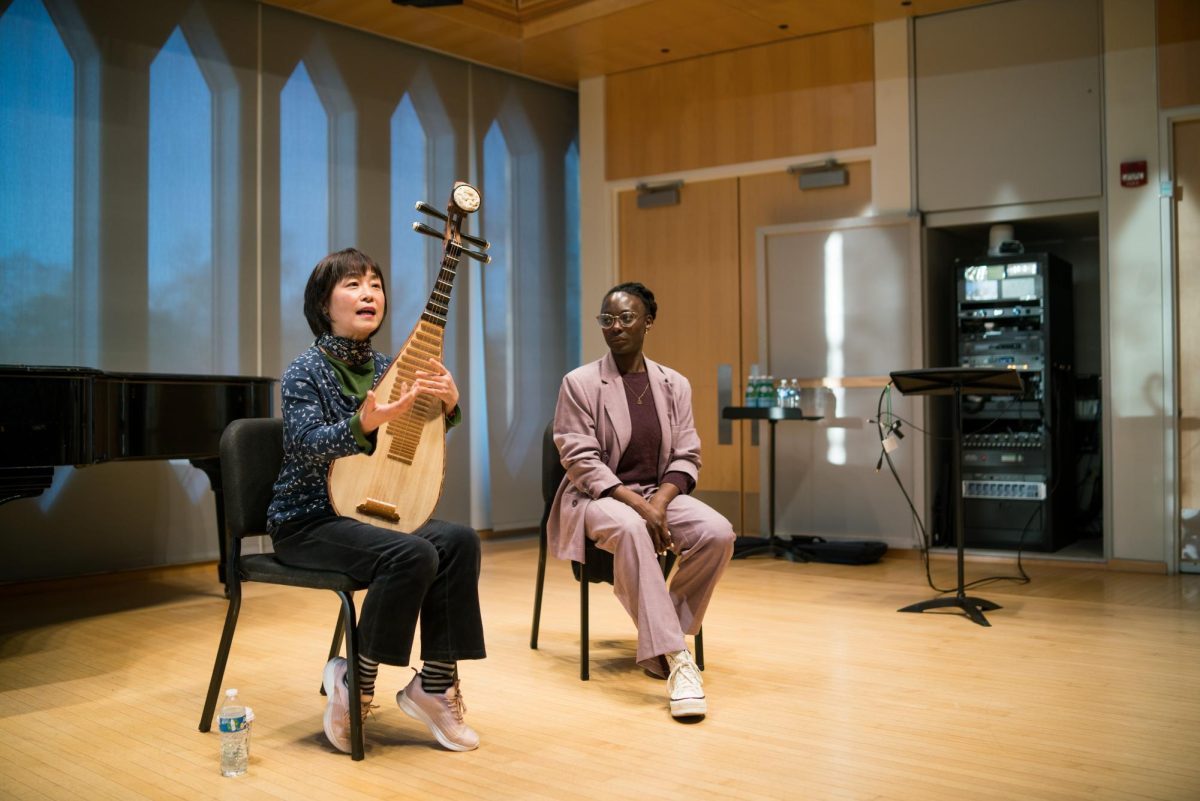On Friday at 7:30 p.m. in Finney Chapel, the Silkroad Ensemble will perform their new program: Uplifted Voices. Rhiannon Giddens, OC ’00, the artistic director of Silkroad, designed this concert series to spotlight overlooked voices and musical origins. Master cellist Yo-Yo Ma formed Silkroad in 1998, using the historical Eurasian Silk Road as a model for the exchange of ideas, traditions, and innovations across borders. The collective continues to use art as a tool to bridge cultures and promote collaboration.
“We build this culture of making music with differences that’s connected through curiosity,” Silkroad percussionist Haruka Fujii said during a panel discussion Thursday. “[This] is something that Yo-Yo Ma … started 24 years ago: the pure curiosity of what happens when strangers meet and try to converse, not with language, but through a musical conversation and exchange.”
Prior to their concert, Fujii and fellow Silkroad members Maeve Gilchrist and Pura Fé presented the vibrant, converging musical traditions they each bring to this conversation.
After completing her undergraduate studies in Japan, her home country, Fujii followed her dream of moving to New York City. She studied Western classical percussion at the Juilliard School and Mannes School of Music. As a percussionist, she struggled to find a focus. She felt a pressure to choose and master a specific instrument, but could never determine which was the right choice. As her arsenal of percussion instruments expanded, she began to appreciate the diversity.
“I became very multi-percussionist,” Fujii said. “When people ask me, ‘How many instruments do you play?’ I can’t count.”
Fujii described her instrument collection as a car junkyard. She performed a concerto with the San Francisco Symphony in which she played a pool of water, splashing and pouring. In homage to her origins, Fujii demonstrated an instrument called the chappa, which consists of two small cymbals attached to the hands. Closed and open claps produce a surprising range of sounds. Through the chappa, which is played during Buddhist ceremonies and festivals, Fujii represents the sounds of Japan.
Maeve Gilchrist moved to the United States at the age of 17 to study and never left. She grew up in Edinburgh, Scotland, where she learned music through an oral tradition.
“Before I could read or write, I learned by ear,” Gilchrist said. “And there was a lot of music in my household. Most social occasions would turn into jam sessions, with fiddles, flutes, and small pipes.”
Gilchrist plays the Celtic harp, whose name alone is the source of cross-cultural debate. The Scottish call the triangular wire-strung instrument a clársach, while in Ireland, it is referred to as an Irish harp. Gilchrist described the confusion and offense this produced when traveling between her home in Scotland and those of her mother’s relatives in Ireland. After moving to America, she landed on the Celtic harp. She refined her piano skills alongside the harp, majoring in jazz improvisation at Berklee College of Music. Though she’s worked with indie pop artists and jazz instrumentalists throughout her musical journey, Gilchrist still considers herself a folk musician. To demonstrate this, she performed a lilting, traditional air, followed by a jazzier contemporary composition. The small, bright-toned harp has ultimately enabled her to collaborate with a wide range of musicians, while retaining a folk music foundation.
Pura Fé was born in New York City. Raised by a family of singers, she was thrown into the musical scene. Without any classical training, Fé began singing in commercial jingles and doing backup vocals for famous artists. As she grew older, she started to explore the music of her ancestors, sparked by her mother’s roots in South Carolina and the Tuscarora Nation. Fé discovered that music from Southeastern Indigenous peoples in North America inspired and informed a lot of the blues and rock music we know today. She formed an Iindigenous women’s acapella group called Ulali, and reinvented this tradition.
“We took a lot of traditional music and started creating other music out of it,” Fé said. “The traditional music from the Southeast is very bluesy. It has a different sound than what most people are used to hearing, but a lot of those sounds are alive today in American music, and people don’t realize that.”
The Silkroad Ensemble embodies the spirit of cultural exchange and collaboration. From Fujii’s eclectic percussion collection to Gilchrist’s exploration of Celtic harp traditions and Fé’s rediscovery of Iindigenous roots in contemporary music, each member contributes to a rich tapestry of sound that celebrates heritage while embracing innovation. The Uplifted Voices program will showcase this diversity, as each piece aims to highlight a certain musician’s cultural heritage and ancestry.





